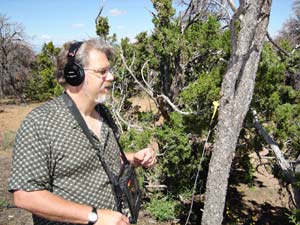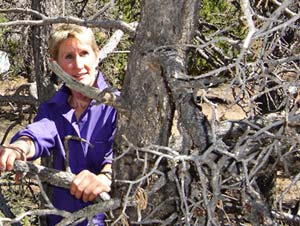Beetle Mania
Air Date: Week of August 12, 2005

Nancy Dahl kneels by a dead piñon tree. (Photo: Paul Ingles)
A sound artist in New Mexico has devised a unique way to save drought ridden pinon trees from falling under attack from the bark beetle. David Dunn listens to the tree to see if it's infested. Paul Ingles reports.
Transcript
CURWOOD: In the drought-stricken desert of northern New Mexico, the once common piñon tree is dying at a rapid rate. The thirsty, weakened trees are falling to an aggressive attack by tiny bark beetles. Some foresters say that there’s little to be done to stop the infestation and that the die-off is actually helping to thin out some areas of forests that are dangerously overgrown. But upset property owners are looking for ways to save their piñons. Producer Paul Ingles met someone in Santa Fe who is offering them help by literally listening to the beetles’ side of the story.
[CRUNCH OF NEEDLES UNDERFOOT]
INGLES: Nancy Dahl walks toward a mostly barren hillside, just a few feet from her southwest-style stucco home on the outskirts of Santa Fe.
[MORE CRUNCHING]
DAHL: We’re now standing on what I call “piñon boot hill.” You can see lots and lots of stumps where I’ve had my trees taken out.
INGLES: Dahl says she’s spent thousands of dollars over the last two years having more than 100 dead piñon trees cut down and hauled off to reduce the threat a wild fire might pose to her home.
[HIGHWAY SOUNDS]
INGLES: When she moved here 25 years ago from Michigan, Dahl found a quiet tree-buffered retreat.
[HIGHWAY SOUNDS]
INGLES: Now, the drone of the nearby highway rolls unfettered up this cleared-off hillside, right through the open windows of her home.
[HIGHWAY SOUNDS, BIRDS CHIRPING]
INGLES: Dahl’s view isn’t what it once was either. Across the highway, a hill of undeveloped open space – once a picturesque dense green – is now half brown with wasted piñons. The trees were killed off by the ips confuses bark beetle infestation that started midway through this region’s now four year drought.
DAHL: It’s very sad. It’s very, very sad for me. Really, these are my friends. These trees were my friends.
INGLES: Another friend of Dahl’s, named David Dunn, stands nearby at the edge of a grove of needleless, dead gray piñons that look like the backdrop for a Halloween play. Like me, he wears headphones and has a recording machine slung on his shoulder. But the device connected to his recorder is a microphone like none I’ve ever seen.

David Dunn listens for bark beetles in a piñon tree. (Photo: Paul Ingles)
DUNN: Basically it’s a meat thermometer meets a greeting card.
INGLES: A greeting card?
DUNN: Some of the best of these piezoelectric transducers actually can be found inside greeting cards, particularly Hallmark make really nice ones that they use as little playback speakers. These little things work both as input and output transducers for sound.
INGLES: While Dunn is becoming known for creating unusual devices for recording the quieter sounds of nature, his resume includes classical training as a violinist, composing and performing experimental music and teaching about the properties of sound. But he’s set aside most of that this year for projects that merge his sound gathering skills with the environmental sciences.
DUNN: I think it is essential that at this point historically that artists take a role in collaboration with the scientific world – that artists and scientists work together towards real world problem solving. We need all the help we can get.
[SOUND OF BARK]
INGLES: Like a nurse administering an IV, Dunn gingerly slips the sharp four-inch metal probe at an angle about a half inch into a tree on Nancy Dahl’s lot.
DUNN: Like that, and that’s all we do. Then we listen to see if there’s any activity.
[WHOOSHING OF NON-INFESTED TREE SOUNDS]
INGLES: These Dunn recordings are amplified about six times over so we can hear them. The sounds we hear first are of a non-infested tree.
[NON-INFESTED TREE SOUNDS]
DUNN: And at this stage there’s virtually nothing. But what you do hear is, of course, is the movement of the tree and the wind and its motion.
[NON-INFESTED TREE SOUNDS]
|
INGLES: It’s when one of Dunn’s probes picks up noises like these that he knows a tree is a goner. [OCCASIONAL CLICKING OF BEETLE-INFESTED TREE] DUNN: As soon as the beetles are present, then we hear this characteristic sound. [MORE CLICKING OF INFESTED TREE] DUNN: The sound of larvae and adult beetle motion. It’s a simple motion within the interior phloem of the tree. [INFESTED TREE SOUNDS] DUNN: And ips beetles, even though they’re very, very small, about the size of a small grain of rice, they have a little sound generating organ on the back of their head called a pars striden. And it essentially functions like a gyro, or a percussion instrument that has ridges on it. So they basically can rub this, their middle of their body, against their heads as they move the heads. And they produce sound both intentionally but also, I think, secondarily as just a consequence of motion within the tree. INGLES: A piñon tree, stressed by lack of water, essentially calls the beetles in by emitting a pheromone that signals it’s too weak to fight. If a beetle started to bore into a healthy piñon, the tree would produce sap to fill the hole and force the beetle out. But without water there’s no sap, and soon the beetles are drilling and breeding and making more of a racket. Here’s Dunn’s recording of a moderately infested tree. [FASTER CLICKING OF BEETLE-INFESTED TREE] INGLES: And before long, it sounds like quite a party in a fully infested tree. [LOTS OF CLICKING OF INFESTED TREE] INGLES: Even at this stage the piñon may look healthy on the outside, but the beetles have sentenced it to death by spreading a black stain fungus on the inside that moves down through the tree’s root structure. There it may spread on its own to other adjacent trees, or the beetles may themselves take the fungus to the next tree. But looking at, say, three apparently healthy piñons side by side is a bit like trying to guess which shell has the pea under it in a shell game. HARRILL: From the point of view of the property owner, you’d like to know whether a tree is infected first. INGLES: Bob Harrill is one of two scientists with David Dunn’s non-profit organization, the Art and Science Laboratory. He’s a doctor of chemistry who’s worked in applied environmental science since the late 1960s. Like Dunn, Harrill likes connecting the worlds of art and science to solve practical environmental riddles like, in this case, which tree has the beetles. HARRILL: We can go out, insert a probe, listen for the presence of the beetle and tell the property owner that this tree is, or this tree is not, infected. That can help them make the decisions on which ones to spray. INGLES: And which ones to water, which can also strengthen the tree against the beetle attack. As word of David Dunn’s technique spreads, he’s been asked by more property owners to listen to their trees. He’s happy to help and gather new data, but he says he’s not trying to create a business opportunity. In fact, if clients insist on paying, he suggests a contribution to his non-profit, so he can afford to make even more recordings and design affordable tools to unearth what Bob Harrill thinks may be a rich field of study. HARRILL: There’s been a great deal of research on what’s called the chemical ecology. How chemicals produced by a tree, for example, might attract a particular pest, like a beetle. But we need to explore more about how sound mechanisms might actually contribute to the interactions between insects and plants. INGLES: Whether Harrill and Dunn’s work can find utility beyond helping individual property owners save a few trees is uncertain. But their work has some state officials intrigued. Forest Service agents are open to the possibility that there might be some future role in forest management for the noises David Dunn and Bob Harrill are gathering. For Living on Earth, I’m Paul Ingles, in Santa Fe. Living on Earth wants to hear from you!Living on Earth Newsletter [Click here]
Donate to Living on Earth! NewsletterLiving on Earth offers a weekly delivery of the show's rundown to your mailbox. Sign up for our newsletter today!
|






